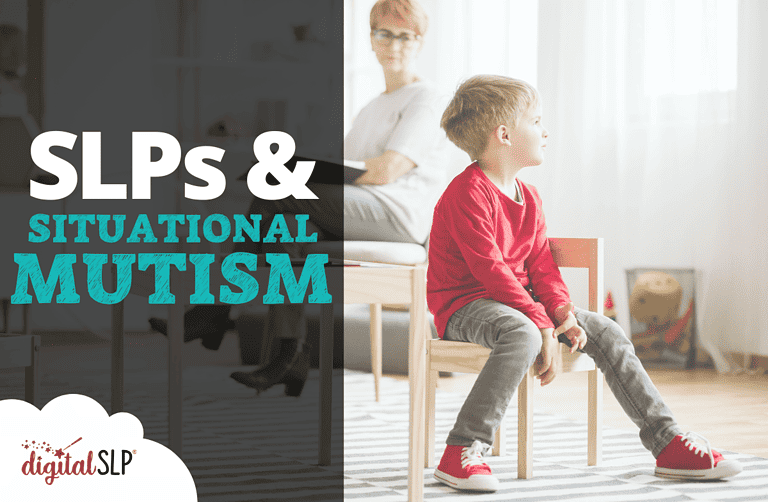Speech-language pathology is a profession of lifelong learning, and sometimes that lifelong learning involves scrambling for resources when a student with an unfamiliar diagnosis lands on our caseloads!
Speed Learning about Selective Mutism
This happened to me when I began working with a student who had a diagnosis of situational mutism (sometimes called selective mutism—more on this later) for the first time. Like many of us, I had gotten a quick overview in graduate school, but I wasn’t exactly sure how to approach treatment. So I read the (limited!) articles that were available, talked to other SLPs, and did my best, but it was clear that more support was needed for SLPs and situational mutism.
Ultimately, my uncertainty helped me, because it meant that I focused on building a safe and supportive relationship with the student, and research suggests that this is a component of effective treatment for selective mutism. But at the time, I was just trying to make it through each session! My student ended up “graduating” from speech about a year later, and I was grateful for the positive outcome and everything I learned.
That experience was a while ago, so I’m excited to refresh my memory and learn what’s new in selective mutism research and treatment. I also hope that this post can be a supportive resource for SLPs who are trying to track down information like I was!
The Basics
Let’s start with the basics. Selective mutism was originally called “elective mutism” when it was added to the DSM-III, but the name was changed in the DSM-IV to indicate that the mutism is related to context, not a conscious choice to stop speaking. But as ASHA points out, even the term “selective” isn’t entirely accurate.
In recent years, there has been a movement to use the term “situational mutism,” which makes sense to me, but the DSM still uses “selective,” and that’s the term I see most often in the literature. I’ll use both (and the common abbreviation SM) in this post.
Within the DSM-V, selective mutism is classified as an anxiety disorder, and these are the (simplified) diagnostic criteria:
- The child consistently doesn’t speak in specific social situations that require speaking (but the child speaks in other situations)
- The lack of speaking impacts educational and/or social outcomes
- The duration is at least one month (not the first month of school)
- The mutism is not due to lack of knowledge of (or comfort with) the spoken language required in a given situation
- The mutism is not better explained by a different underlying communication disorder, and is not due to autism, schizophrenia, or other diagnoses
Prevalence and Causes
Situational mutism is relatively rare, with most prevalence estimates ranging between 1% and 2%. No one has identified a single underlying cause, but many possibilities have been suggested, including genetics, parenting style, family environment, overactive autonomic nervous system responses, and psychological factors.
Whether or not psychological factors actually cause selective mutism, it’s important to be aware of them, because researchers have found that 80% of children with selective mutism are also diagnosed with other anxiety disorders. So, even though anxiety is (somewhat strangely) not part of the diagnostic criteria for selective mutism, it’s likely that these students live with anxiety in some way or another.
Triggers
Related to causes, researchers have also looked at common characteristics of triggers for selective mutism, and found that the triggers usually involve a combination of people, places, and activities. The most common characteristic of people who triggered situational mutism was that they didn’t respect the child’s need for physical or psychological distance. The most common triggering characteristic of both places and activities was lack of familiarity.
This is vital for SLPs to know and share, because one of our first steps in treating selective mutism can be identifying and removing triggers if possible. In fact, some research on treatment outcomes for SM shows that one of the most effective treatments (in terms of recovery rates) is actually for the child to change schools. Changing schools is disruptive for the student and their family, so if we can address the trigger, everyone wins!
When we look at SM outcomes overall, there’s good news and bad news. A systematic literature review found that recovery rates were fairly high, ranging from 39% to 92%, but the same study also found that up to 58% of subjects went on to receive additional psychiatric diagnoses later in life.
The SLP’s Role
As you see words like “anxiety,” “psychological factors,” and “psychiatric diagnoses,” you might be wondering how SLPs fit into the treatment picture for situational mutism, and that’s a valid question! It’s one of those diagnoses where things can get very murky. I’ll offer some thoughts, but your reality could be drastically different depending on your specific setting.
Evaluation and Eligibility
In public schools, one of the trickiest considerations when evaluating and serving students with SM (or suspected SM) is determining the eligibility category. The Individuals with Disabilities Education Act (IDEA) has 13 different disability categories under which a student could be found eligible. Speech or language impairment is one of these categories, and I have definitely heard of students with selective mutism qualifying under this category.
On a certain level, I see how this makes sense, because the student’s communication is the primary area of concern. At the same time, the actual diagnostic criteria in the DSM stipulate that an SM diagnosis only applies if speech and language impairments have been ruled out, so could speech/language really be the disability category? It gets messy!
I don’t have easy answers, especially since options and regulations vary widely by state and district. But I do know that it’s crucial for SLPs to be active (and vocal) members of the evaluation team. Our role is so important when SM is suspected, because we are the professionals who have the expertise to rule out other possible causes of the student’s difficulties with spoken language. (ASHA has a very helpful guide for how to approach the evaluation process in its selective mutism practice portal.)
Considering Accommodations
If we determine that there are no underlying language-based disabilities, the team conversations about eligibility and services may be very complex. One useful step is making sure that the team considers all possible support options, including a 504 plan with accommodations. Given that SM is triggered by the student’s context, it’s logical that the most effective interventions would remove barriers from the context—and that’s exactly what effective accommodations do!
But we do need to be thoughtful about potential accommodations. Most researchers suggest a behavioral approach to situational mutism treatment, and they caution against enabling any avoidance on the student’s part. This is where identifying specific triggers is so important—we probably wouldn’t want to have an accommodation that allows the student to skip a certain class, but if the student’s mutism is triggered because the teacher in that class changes plans frequently, the student could have an accommodation that involves getting advance notice of schedule adjustments.
Accommodations may also be necessary to support health and safety. For example, if a student is unable to say that they need the restroom, they may need a visual signal or some other type of strategy as an accommodation.
There are so many potential outcomes for any SM evaluation process; we could never identify and discuss them all! So let’s jump to one of the most challenging scenarios: the student is added to your caseload, and you’re not sure how to proceed with treatment.
Situational Mutism Treatment Principles
It’s clear that there isn’t enough high-quality research available about treatment options for SM, so it makes sense when we feel overwhelmed and confused. But everything we know (and we know a lot!) about shaping and facilitating language still applies.
However, we might need to adjust our approach, and the research does have ideas for how to do this. Two treatment principles that some of the most successful treatment options have in common are defocused communication and child-directed interaction.
Defocused communication involves taking direct attention (and pressure!) off the student during sessions. This could look like:
- Sitting next to the student
- Using an enjoyable activity to create joint attention with the student
- Using “think alouds” instead of asking the student direct questions
- Giving plenty of wait time
- Avoiding talking for the student—but keeping the conversation going even if the student doesn’t respond
- Reacting in a neutral way (instead of with obvious enthusiasm) if/when the student responds using spoken language
Many of us are probably familiar with child-directed interaction (it’s a common principle in early intervention), but just as a refresher, it includes letting the student take the lead, praising the student for target behaviors, and reflecting/imitating the student’s actions and play.
As we think about treatment specifics, it can also be helpful to revisit the categories of speaking situations that students with selective mutism often avoid due to triggers: people, places, and activities. We can break these down and write goals and plan activities that reflect our ultimate goal, which is to help the student communicate successfully with more people, in more places, during more activities.
Over time, this expanded communication could support the student in living a big, brave life, and this is such a meaningful pursuit! But it’s also challenging, and there’s always more to learn. I hope the ideas from this post and the resources I include below are helpful as you continue to build your situational mutism confidence!
References and Resources:
Anxiety in Children with Selective Mutism: A Meta-analysis
ASHA Selective Mutism Practice Portal
“Brave Talking” Helps Kids Beat Anxiety
Characteristics of person, place, and activity that trigger failure to speak in children with selective mutism
Climbing the Ladder: Practicing Brave Talking
Current diagnostic criteria for selective mutism as described in the DSM-5
Individuals with Disabilities Education Act (IDEA)
Long-term Outcomes of Selective Mutism: A Systematic Literature Review
Selective Mutism and Autism
Selective Mutism Association
Selective Mutism Information & Research Association
Situational Mutism
Situational Mutism Information Pack
Podcast Episode 25 – Selective Mutism: What it is & How to Treat it













Recent Comments